
iStudy for Success!
Online learning tutorials for essential college skills.
iStudy would like to acknowledge Kathy Maxwell for revising the content of this tutorial.

Students, workers, and parents—actually almost everyone—experience a substantial amount of stress. Not all stress is bad. It is perfectly natural and an important part of life. This kind of stress is called eustress. However, stress in its negative forms, or stress that continues for too long (distress), can affect health, productivity, and one's outlook on life.
Stress can manifest itself physically and psychologically. Life changes or events play a big part in the amount of stress that is present. Increasing one's knowledge of stress and how it is perceived is an important part of managing it. Therefore, the more you know about yourself, your habits, your strengths, and your weaknesses, the easier it is to take control when possible—or cope and manage when it isn't possible.
The goal of this tutorial is to introduce you to the things that cause stress in your life and to help you acquire basic skills for managing stress in your academic, professional, and personal life.
Upon completing the Stress Management tutorial you will be able to:
Note: All external links in this tutorial will open in a new window or tab.
Sage: Hey Brian, what's up? How are your classes going?
Brian: They're not. No matter how much I try, I just can't seem to get anything done.
Sage: Sounds like you have some stuff happening. Do you have any idea what's up?
Brian: No. I'm just really confused about what I need to know for class and I can't seem to get going. I can't stay focused. I'm really tired and sometimes I even fall asleep in class.
Sage: Why don't you take a break now and I'll try to calm you down a little. I know some stress relief methods.
Brian: That sounds great, if you don't mind helping me out.
Sage: No problem. Let's start with a few questions. Do you think you get enough sleep at night?
Brian: Not really. I have to work and study, so I probably only get about four or five hours if I'm lucky.
Sage: What about exercise? You should try to exercise at least three days a week.
Brian: The only exercise I get is walking back and forth to class.
Sage: Hmmmm... I bet you're eating a lot of junk food, too, right?
Brian: Yeah, I am, but I don't have the time to sit down and eat regular food.
Sage: I know what you mean. I can't tell you how many times I've ordered pizza this month just because I didn't have the time to make myself a real meal. What about your friends? I know it helps me out a lot, when I'm feeling lousy, to talk to my friends. It really cheers me up.
Brian: Well, I used to talk to my friends all the time, but ever since I got into this slump I've sort of lost touch with them. Sometimes someone will call and see if I want to go out.
Sage: Well? Do you go?
Brian: Yeah, sometimes, but not as often as I used to.
Sage: Whoa! When I first met you, you used to party till, well, the cows came home.
Brian: Yeah, now I find myself hanging out in my room a lot just watching TV.
Sage: Is something worrying you? Something making it hard to concentrate?
Brian: I guess I'm worried about grades, work, and especially letting my parents down. The more I think about this stuff, the worse it gets and the less I get done.
Sage: It really sounds like a vicious cycle, and what we need to work on is breaking that cycle so you can start focusing on your work again.
Brian: That sounds great Sage, but how do I get started?
Sage: Actually, you've already started. You see, what you just did is called an awareness check. You found out that you're not getting enough sleep and your eating habits need to change. You need more exercise to stop your body from tiring out, and you need to keep in touch with your friends who support you and keep you in a positive frame of mind. You have something to work with there.
Brian: Wow, I didn't realize that all those things could be connected to how I feel.
Sage: So, how do you usually cope when you feel uptight and stressed out?
Brian: Well, in high school I used to run whenever I felt stressed, but now I think that I really like listening to music and zoning out.
Sage: How do you feel after you're done listening to music?
Brian: I feel a little more relaxed. Sometimes it puts me to sleep.
Sage: Maybe you should run AND listen to music!
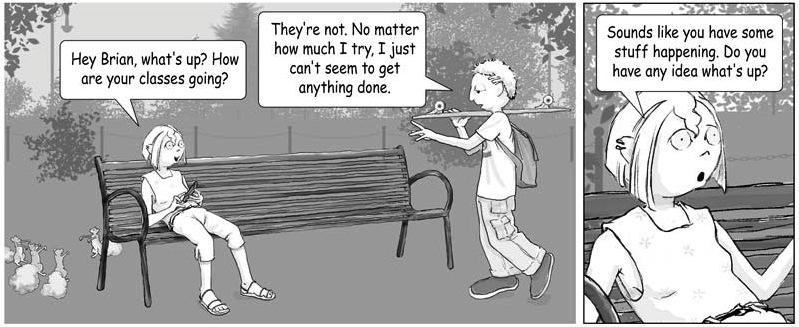

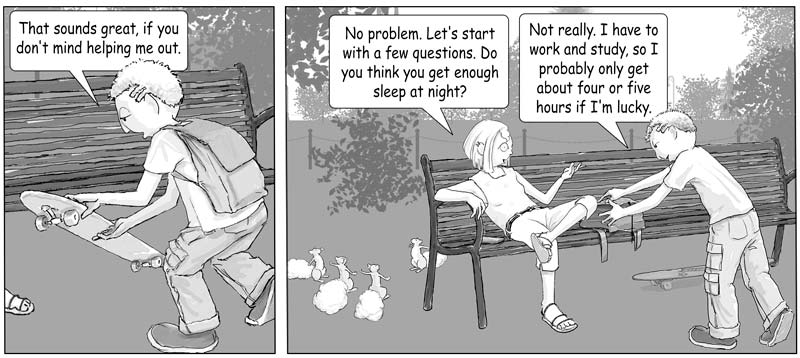
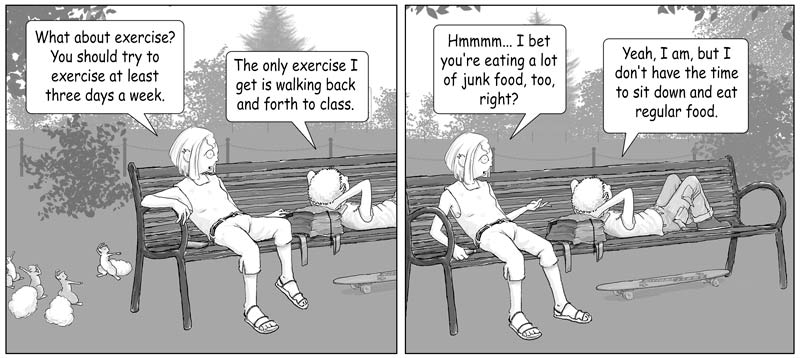
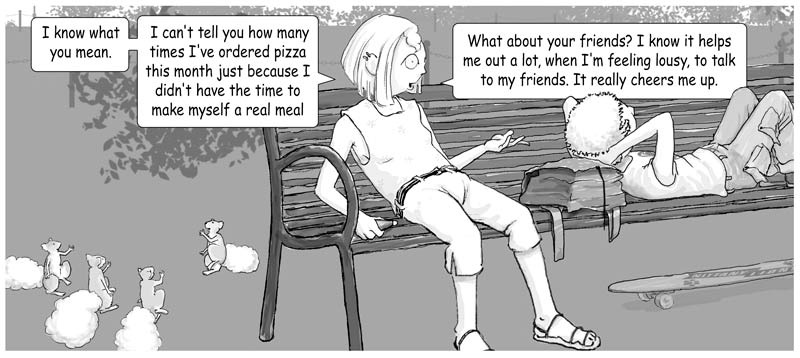
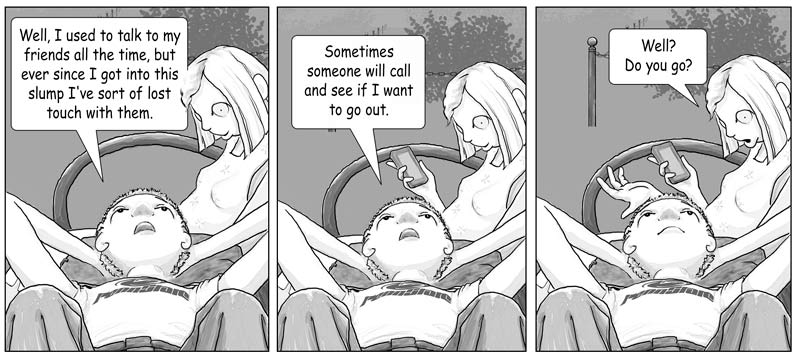
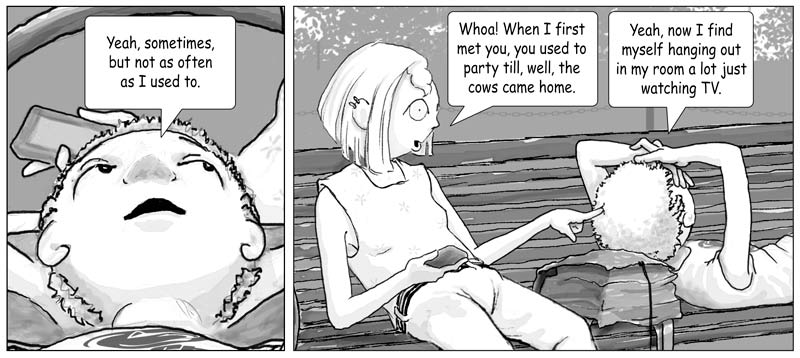
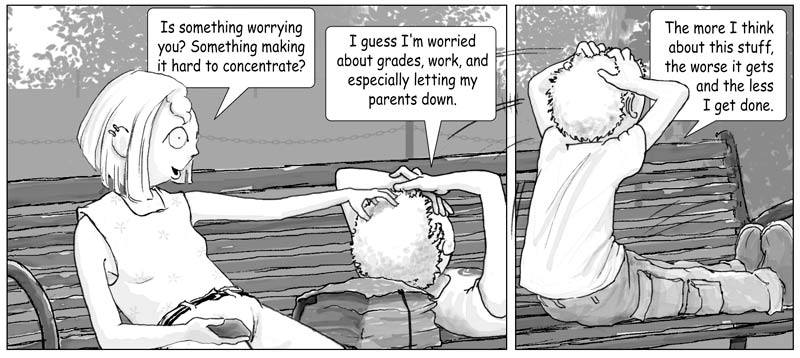
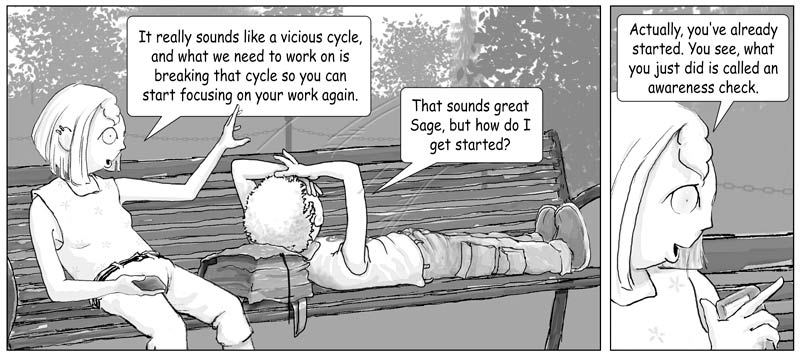
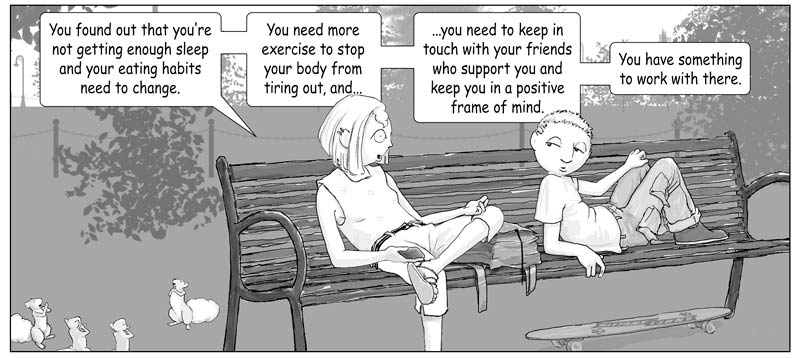
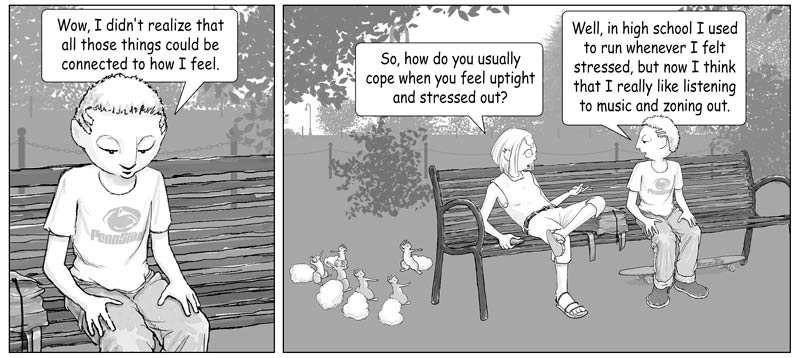
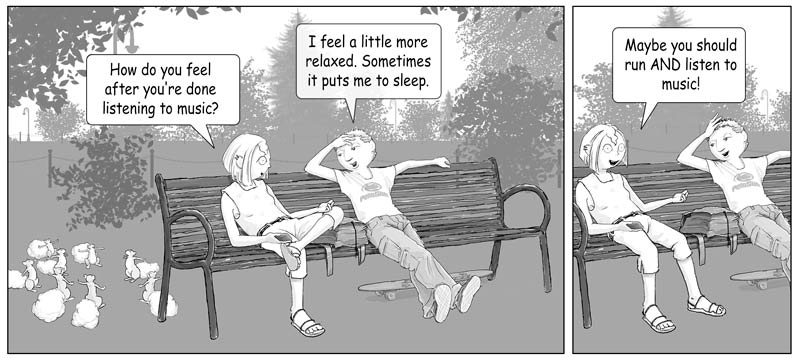
Think about the distress of the person described. What are the symptoms that indicate he is feeling distressed? What are the causes of his distress? What are some things he could do to feel less distressed? Identify the stressors and stress triggers in each of these three situations.

Signs of Stress is your assessment of signs of stress that you show and how often you experience them. The worksheet lists many different signs of stress that you should be aware of in order to deal with them.
Note: A downloadable RTF file of this worksheet is included in the left sidebar of this page.
Name: ________________
Date: _________________
DIRECTIONS: Look at the following symptoms of stress. Place a checkmark in the column marked "R" if you experience this symptom rarely. Place a checkmark in the column marked "O" if you experience it often.
|
R |
O |
|
|
|
|
1. Headaches |
|
|
|
2. Stomach problems – diarrhea, constipation, nausea, heartburn, urinating often |
|
|
|
3. High blood pressure or heart pounding |
|
|
|
4. Pain in neck, lower back, shoulders, jaw |
|
|
|
5. Muscle jerks or tics |
|
|
|
6. Eating problems – no appetite, constant eating, full feeling without eating |
|
|
|
7. Sleeping problems – unable to fall asleep, wakeful in middle of night, nightmares |
|
|
|
8. Fainting |
|
|
|
9. General feeling of tiredness |
|
|
|
10. Shortness of breath |
|
|
|
11. Dry throat or mouth |
|
|
|
12. Unable to sit still – extra energy |
|
|
|
13. Teeth grinding |
|
|
|
14. Stuttering |
|
|
|
15. Uncontrollable crying or not being able to cry |
|
|
|
16. Smoking |
|
|
|
17. Excessive alcohol use |
|
|
|
18. Excessive drug use |
|
|
|
19. Increased use of medication – aspirin, tranquilizers, etc. |
|
|
|
20. General anxiety, nervous feeling, or tenseness |
|
|
|
21. Dizziness and weakness |
|
|
|
22. Irritable and easily upset |
|
|
|
23. Depressed |
Stress Diary is for recording descriptions of the triggers, the situations, your reactions, etc. to stressors that occur during the day. Use this form to record information about yourself for 6 days.
Note: A downloadable RTF file of this worksheet is included in the left sidebar of this page.
Name: Nancy
Date: April 19, 2012
Circle One: S M T W Th F S
Review the sample diary form below for directions on completing the Stress Diary.
|
Time of |
Intensity of |
Duration of |
Situation (circumstance, location, people) |
Triggering Event (preceding event) |
Emotional Behavioral Reaction (your feelings about the event) |
|
9AM |
4 |
30 min |
Woke up too late and missed the first class. |
I went to a fun party that lasted until 2:00 a.m. yesterday.
|
I got mad at my roommate that she didn't call me for the class at 7:00. |
|
4PM |
7 |
1 hour |
I couldn't finish the assignment that was due by class today although I worked very hard all morning. It took longer to finish than I expected. |
Set unrealistic time frame or the assignment |
I was extremely nervous because of not being able to finish the assignment on time. |
|
6PM |
6 |
All evening |
I have too many assignments due by the end of this week. |
I put off doing all of my assignments until the last minute and now need to finish all the assignments in one week under deadline pressure. |
I worried about the assignments and kept muttering and complaining about having too many assignments. I feel pain in my neck and lower back every time I think about having so many assignments to do. |
|
8PM |
3 |
1 hour |
The weather was too cold. |
I didn't wear enough clothes when I went out for a walk. |
I was really cold and I was angry about the unexpected cold weather in this region. |
Name:
Date: Circle One: S M T W Th F S
Complete the Stress Diary below. Copy this form for additional space.
|
Time |
Intensity |
Duration |
Situation |
Triggering Event |
Emotional Behavioral Reaction |
|
|
|
|
|
|
|
|
|
|
|
|
|
|
|
|
|
|
|
|
|
|
|
|
|
|
|
|
Stress Worksheet will help you summarize the data you collected in your Stress Diary and identify coping and prevention strategies for the stress involved. Complete this worksheet after you have recorded data in your Stress Diary for 6 days.
Note: A downloadable RTF file of this worksheet is included in the left sidebar of this page.
Review your Stress Diary. From your stress list, identify examples of eustress and distress in the space below.
Eustress ______________________________________________________________________________
Distress ______________________________________________________________________________
|
Stressors |
Symptoms |
|
|
Physical |
Mental |
|
|
|
|
|
|
|
|
|
|
|
|
|
|
|
|
|
|
|
|
|
|
|
|
|
Here are some examples of things you can do to reduce your level of stress
|
Exercise |
|
|
Nutrition |
|
|
Sleep |
|
|
Stimulants |
|
|
Support System |
|
|
Nurture-Self |
|
|
Good time management skills |
|
|
Relax |
|
Think about how to cope with and prevent the distress you identified in your Stress Diary and the questions above. Describe your plan for coping with distress in the space below.
|
Exercise |
|
|
Nutrition |
|
|
Sleep |
|
|
Stimulants |
|
|
Support System |
|
|
Nurture-Self |
|
|
Good time management skills |
|
|
Relax |
|
Use the "Prioritizing and Strategizing" activity sheet to list the ten things that caused you the most distress during the week, and then rank them from most to least stressful in terms of how much trouble they tended to cause you.
Write a short comment, note, or reminder about what you think the cause of each stressor may have been and how you can cope with it or eliminate it in the future.
Note: A downloadable RTF file of this worksheet is included in the left sidebar of this page.
List the top 10 stressors from your Stress Diary and prioritize them from most stressful (10) to least stressful (1). In the comments column, briefly describe what you will do to either cope with the stress or eliminate it.
|
Rank (1-10) |
10 Stressors |
Comments |
|
|
|
|
|
|
|
|
|
|
|
|
|
|
|
|
|
|
|
|
|
|
|
|
|
|
|
|
|
|
|
|
|
|
|
|
|
|
|
|

Most of the materials presented here were developed in consultation with Dr. Linda Shoop, Penn State. There are also many stress management resources available on the web.
* Indicates that the original Website is no longer available.
Following are the assignments embedded in the Stress Management tutorial:
This tutorial is related to other tutorials on personal effectiveness, including active listening, active reading, project management, interview skills, note-taking, peer tutoring, and brainstorming. In particular, stress management is directly related to conflict management and time management. Therefore, it is recommended that instructors introduce this tutorial to students in conjunction with other personal effectiveness tutorials.
These points are covered in the iStudy tutorial, but should be emphasized in any discussions.
The following might be signs of possible stress:
The iStudy tutorial includes a number of activities the instructor may find appropriate as assessment devices. First, each student completes a Signs of Stress worksheet as an assessment of the signs of stress the students can identify in their lives and how often they experience them. A worksheet listing different signs to look for is provided to aid the student.
The second assignment, a Stress Diary, is for recording stressors that occur during the student's day and descriptions of the trigger(s), the situation, his/her reaction, etc.
The third assignment is a Stress Worksheet. It helps the student identify a specific stress and whether it is of the positive (eustress) or negative (distress) variety. After identifying the typical stress that he/she has in his/her life, the student is then asked to rank these stressors and provide the causes of each.
Assessment criteria are as follows (Instructors supply the percentage weights):
|
Where |
Domain |
Activities |
% |
|---|---|---|---|
|
iStudy Tutorial |
Knowledge |
The student can identify stressors, stress triggers, and common symptoms in a given personal situation by listing them. |
|
|
iStudy Tutorial |
Comprehension |
The student can distinguish specific stresses as eustress or distress by giving his/her examples. |
|
|
In-Class |
Application |
The student can manage or cope with stress by using Stress Diary, Signs of Stress, and Stress Worksheet. |
|
|
|
|
|
100% |